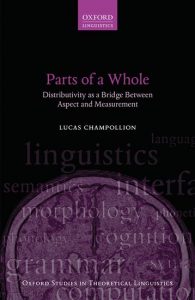This book uses mathematical models of language to explain why there are certain gaps in language: things that we might expect to be able to say but can’t. For instance, why can we say I ran for five minutes but not *I ran to the store for five minutes? Why is five pounds of books acceptable, but *five pounds of book not acceptable? What prevents us from saying *sixty degrees of water to express the temperature of the water in a swimming pool when sixty inches of water can express its depth? And why can we not say *all the ants in my kitchen are numerous? The constraints on these constructions involve concepts that are generally studied separately: aspect, plural and mass reference, measurement, and distributivity. In this book, I provide a unified perspective on these domains, connect them formally within the framework of algebraic semantics and mereology, and use this connection to transfer insights across unrelated bodies of literature and formulate a single constraint that explains each of the judgments above.
Obtaining the book
- Available directly from Oxford University Press as paperback (US/UK) or hardcover (US/UK).
Use promotion code AAFLYG6 to save 30%. - Available from Amazon.com as paperback or hardcover.
- Available from Amazon.co.uk as paperback or hardcover.
- List of sellers from Google Books.
- Find in a library (WorldCat).
- Available as an electronic text for subscribers of Oxford Scholarship Online.
- Available as a print replica ebook (not a PDF but looks like one) from Google Play for US$43.44.
Excerpts
Posted with permission by the publisher:
- Table of Contents (PDF)
- Acknowledgments (PDF)
- Includes detailed information about relevant previous work the book subsumes
- Chapter 1 (PDF)
- Contains an introduction of the framework, abstracts of subsequent chapters, and suggested paths through the book based on whether your main interest is in aspect, distributivity, or measurement.
- Conclusion (PDF)
- As requested by the publisher, the conclusion chapter is taken from the typescript and not from the proofs. The text is essentially the same, but the pagination is different.
- All excerpts combined in a single file (PDF)
- Partial preview of the book on Google Books
Citing the book
- Champollion, Lucas. 2017. Parts of a whole: Distributivity as a bridge between aspect and measurement. Vol. 66 (Oxford Theoretical Studies in Linguistics). Oxford, UK: Oxford University Press. ISBN 978-0-19-857513-5. DOI 10.1093/oso/9780198755128.001.0001
- BibTeX code (.TXT)
Relation to previous published work
This book is a substantially reworked and extended revision of my 2010 dissertation, which it supersedes. I first introduced the framework of strata theory and the concept of stratified reference in that dissertation, and I have used it in my research ever since. The book collects in one place all the work I have carried out on algebraic semantics and mereology from about 2009 to 2016, and presents it in a unified and self-contained way. It is planned and written as a coherent whole and not merely a collection of papers. I have published some parts as self-contained articles over the last few years. The revisions to the theory that resulted from peer review have been propagated through the book.
- I published an overview of strata theory in 2015 as a target article in the open peer-review journal Theoretical Linguistics (preprint). This article mostly centers on applications to aspect and measurement but also discusses distributivity. The responses to the target article prompted me to develop strata theory further, in particular by refining the definition of stratified reference. This is described in details in this reply article (preprint). I have folded these refinements back into the text of the dissertation as I prepared it for publication as a book.
- Parts of chapter 2, which is about background assumptions, appeared in 2016 as a handbook article on linguistic applications of mereology coauthored with Manfred Krifka (preprint).
- Chapter 8, on covert distributivity, has been significantly expanded for publication in the open-access journal Semantics and Pragmatics, where it appeared in 2016.
- Chapter 9, on overt distributivity, was written after the dissertation was completed and published in Semantics and Pragmatics, back-to-back with the previous chapter.
- Chapter 10, on the word all, is based on chapter 9 of the dissertation and has undergone substantial revision. Setting aside a brief NELS proceedings paper in 2016, most of this chapter has not appeared anywhere else.
- Chapter 11, the conclusion of the book, has been rewritten from scratch and substantially expanded to include a detailed chapter-by-chapter summary and many suggestions for future work.
- Compared with the dissertation, chapters 1-4 and 6-7 have been only lightly changed; chapter 5 has been partly rewritten.
Other related materials
- 2015 lecture notes
- These lecture notes are for a 4-5 lecture, introductory course on linguistic applications of mereology. I taught this course at ESSLLI and NASSLLI 2014 and at the 2015 LSA Institute, and I taught it again at ESSLLI 2017. It corresponds roughly to chapter 2 of the book.
- 2014 lecture notes (longer but not up-to-date)
- These lecture notes are for a one-semester graduate seminar that covers essentially the entire book. I taught this course at NYU in Spring 2013 and Fall 2014. They are slightly out of date because they do not incorporate the developments that were triggered by the 2015 target article in Theoretical Linguistics.
- 2010 dissertation (supervisor: Cleo Condoravdi)
- The dissertation is superseded by the book; its full text is available from Penn’s open-access repository.
- Slides of a 2017 summary talk about the book
- The talk gives a somewhat simplified top-down overview of the framework in the book, focusing on distributivity.
- YouTube video of a 2015 summary talk
- This talk showcases the framework from a bottom-up perspective, motivating it step by step via measurement and aspect. Here is its handout (PDF).
